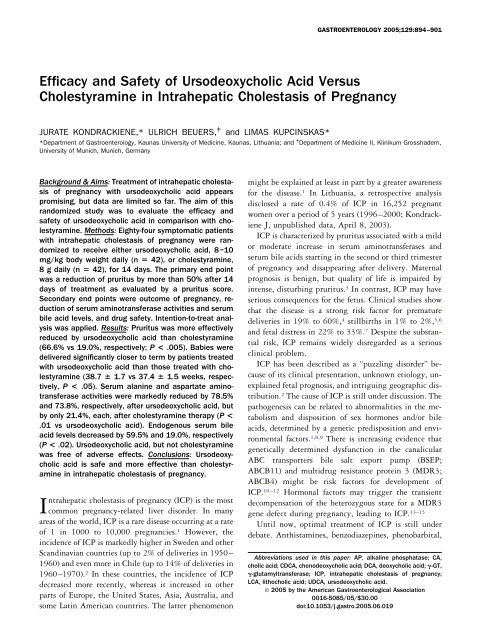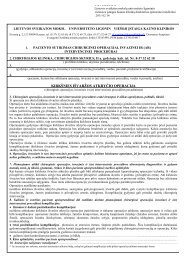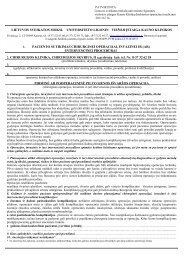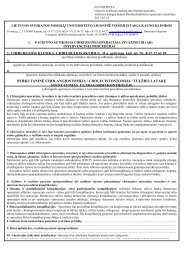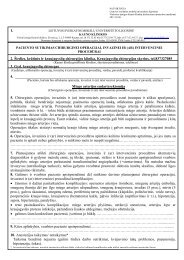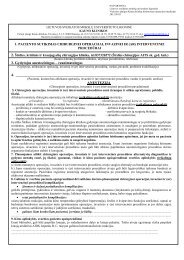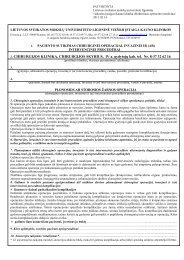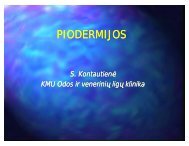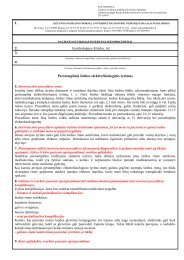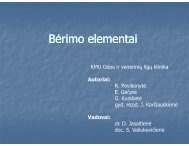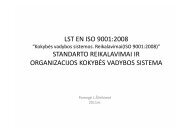Efficacy and Safety of Ursodeoxycholic Acid Versus Cholestyramine ...
Efficacy and Safety of Ursodeoxycholic Acid Versus Cholestyramine ...
Efficacy and Safety of Ursodeoxycholic Acid Versus Cholestyramine ...
- No tags were found...
Create successful ePaper yourself
Turn your PDF publications into a flip-book with our unique Google optimized e-Paper software.
GASTROENTEROLOGY 2005;129:894–901<strong>Efficacy</strong> <strong>and</strong> <strong>Safety</strong> <strong>of</strong> <strong>Ursodeoxycholic</strong> <strong>Acid</strong> <strong>Versus</strong><strong>Cholestyramine</strong> in Intrahepatic Cholestasis <strong>of</strong> PregnancyJURATE KONDRACKIENE,* ULRICH BEUERS, ‡ <strong>and</strong> LIMAS KUPCINSKAS**Department <strong>of</strong> Gastroenterology, Kaunas University <strong>of</strong> Medicine, Kaunas, Lithuania; <strong>and</strong> ‡ Department <strong>of</strong> Medicine II, Klinikum Grosshadern,University <strong>of</strong> Munich, Munich, GermanyBackground & Aims: Treatment <strong>of</strong> intrahepatic cholestasis<strong>of</strong> pregnancy with ursodeoxycholic acid appearspromising, but data are limited so far. The aim <strong>of</strong> thisr<strong>and</strong>omized study was to evaluate the efficacy <strong>and</strong>safety <strong>of</strong> ursodeoxycholic acid in comparison with cholestyramine.Methods: Eighty-four symptomatic patientswith intrahepatic cholestasis <strong>of</strong> pregnancy were r<strong>and</strong>omizedto receive either ursodeoxycholic acid, 8–10mg/kg body weight daily (n 42), or cholestyramine,8 g daily (n 42), for 14 days. The primary end pointwas a reduction <strong>of</strong> pruritus by more than 50% after 14days <strong>of</strong> treatment as evaluated by a pruritus score.Secondary end points were outcome <strong>of</strong> pregnancy, reduction<strong>of</strong> serum aminotransferase activities <strong>and</strong> serumbile acid levels, <strong>and</strong> drug safety. Intention-to-treat analysiswas applied. Results: Pruritus was more effectivelyreduced by ursodeoxycholic acid than cholestyramine(66.6% vs 19.0%, respectively; P < .005). Babies weredelivered significantly closer to term by patients treatedwith ursodeoxycholic acid than those treated with cholestyramine(38.7 1.7 vs 37.4 1.5 weeks, respectively,P < .05). Serum alanine <strong>and</strong> aspartate aminotransferaseactivities were markedly reduced by 78.5%<strong>and</strong> 73.8%, respectively, after ursodeoxycholic acid, butby only 21.4%, each, after cholestyramine therapy (P
September 2005 UDCA VS CHOLESTYRAMINE IN ICP 895dexamethasone, epomediol, S-adenosyl-L-methionine,<strong>and</strong> cholestyramine have been used without clear evidence<strong>of</strong> efficacy. <strong>Cholestyramine</strong> has been used for reducingpruritus. Observational studies suggest that cholestyraminemay be associated with improved maternalmorbidity without a documented improvement in fetaloutcome. 16–18 <strong>Cholestyramine</strong> may worsen the malabsorbtion<strong>of</strong> fat-soluble vitamins, especially vitamin K. Acase report <strong>of</strong> severe fetal intracranial hemorrhage duringtreatment with cholestyramine for ICP has raised thepossibility that severe maternal vitamin K deficiencymay lead to fetal vitamin K deficiency <strong>and</strong> coagulopathy.18 Recently, ursodeoxycholic acid (UDCA) has beenproposed for the treatment <strong>of</strong> ICP. Improvement inmaternal <strong>and</strong> fetal morbidity was suggested in 8 clinicaltrials <strong>and</strong> several observational studies, although thesestudies were small <strong>and</strong> in some aspects inconsistent. 16,17However, data from large, r<strong>and</strong>omized trials <strong>of</strong> treatment<strong>of</strong> ICP are lacking. Therefore, the aim <strong>of</strong> the presentstudy was to evaluate the efficacy <strong>and</strong> safety <strong>of</strong> UDCA inpatients with ICP in comparison with cholestyramine.UDCA <strong>and</strong> cholestyramine were administered at moderatedoses to alleviate the risk <strong>of</strong> formation <strong>of</strong> potentiallytoxic bile acid metabolites <strong>and</strong> <strong>of</strong> malabsorption <strong>of</strong> fatsolublevitamins, respectively.Materials <strong>and</strong> MethodsStudy DesignAn open, r<strong>and</strong>omized, parallel group study was performedcomparing the efficacy <strong>and</strong> safety <strong>of</strong> UDCA <strong>and</strong> cholestyraminein intrahepatic cholestasis <strong>of</strong> pregnancy. The studywas approved by the ethics committee <strong>of</strong> the Kaunas MedicalUniversity. The study was conducted in accordance with theethical guidelines <strong>of</strong> the Declaration <strong>of</strong> Helsinki.PatientsPatients with a diagnosis <strong>of</strong> ICP as defined by thecriteria below were prospectively evaluated for inclusion in thisstudy between October 1999 <strong>and</strong> September 2002.Inclusion criteria were as follows: skin pruritus starting inthe second or third trimester <strong>of</strong> pregnancy <strong>and</strong> elevation <strong>of</strong> atleast one <strong>of</strong> the following biochemical parameters above theupper limit <strong>of</strong> normal: alanine aminotransferase (ALT) 45U/L, aspartate aminotransferase (AST) 40 U/L, <strong>and</strong> fastingserum bile acids 10 mol/L. Exclusion criteria were asfollows: chronic liver disease, hepatic viral infections (HAV,HBV, HCV, cytomegalovirus, Herpes simplex virus, Epstein-Barr virus), skin disease, allergic disease, <strong>and</strong> symptomaticcholelithiasis.All patients gave written informed consent before inclusioninto the study <strong>and</strong> were r<strong>and</strong>omized to receive either UDCA,8–10 mg/kg body weight per day (Urs<strong>of</strong>alk capsules; Dr. Falk,Pharma GmbH, Freiburg, Germany), or cholestyramine, 8g/day (Ratiopharm GmbH & Co, Ulm, Germany), for 14 days.R<strong>and</strong>omization was performed by use <strong>of</strong> sealed envelopes.Study End PointsThe primary study end point was defined as a reduction<strong>of</strong> severity <strong>of</strong> pruritus by more than 50% after 14 days <strong>of</strong>treatment. Secondary end points were outcome <strong>of</strong> pregnancy(term <strong>of</strong> delivery, Apgar score, newborn status), reduction <strong>of</strong>serum aminotransferase activities <strong>and</strong> serum bile acids levels,<strong>and</strong> drug safety. Self-assessment <strong>of</strong> pruritus intensity wasperformed by the patients daily by use <strong>of</strong> a score from 0 to 4(0, no pruritus; 1, occasional; 2, intermittent pruritus everyday with asymptomatic periods prevailing; 3, intermittentpruritus every day with symptomatic periods prevailing; 4,constant pruritus day <strong>and</strong> night).Serum liver tests, fasting serum bile acids <strong>and</strong> cholic (CA),chenodeoxycholic (CDCA), deoxycholic (DCA), lithocholic(LCA), <strong>and</strong> ursodeoxycholic (UDCA) acids were evaluated atentry <strong>and</strong> on the day after end <strong>of</strong> therapy. Abdominal ultrasonography<strong>and</strong> serologic tests (see inclusion <strong>and</strong> exclusioncriteria) were performed before treatment. Serum liver testswere determined using routine laboratory techniques. Fastingserum levels <strong>of</strong> bile acids were determined as described previously.19 In brief, bile acids were extracted with Bond-Elut C18cartridges (Analytichem International, San Diego, CA), solvolysiswas performed to cleave sulfate groups, <strong>and</strong> enzymatichydrolysis was performed to deconjugate bile acid amidates.Deconjugated bile acids were isolated by extraction on Lipidex1000 (Packard Instruments, Groningen, The Netherl<strong>and</strong>s) <strong>and</strong>were then methylated <strong>and</strong> trimethylsilylated for gas chromatography.Capillary gas chromatography was performed usinga Carlo Erba Fractovap 4160 gas-chromatograph (Carlo ErbaInstruments, H<strong>of</strong>heim, Germany). Bile acid derivatives wereseparated on a fused silica capillary CP Sil 19 CB columncoated with chemically bonded OV-1701 (25 m 0.33 mm,Chrompack, Middelburg, The Netherl<strong>and</strong>s). Hydrogen wasthe carrier gas (P .6 kg/cm 2 ). A temperature program from140°C to 270°C with 8°/min was started after on-columninjection. Eluting bile acid derivates were detected by a flameionization detector. Fasting serum samples were stored at20°C until analyzed.The fetal status was monitored in the same hospital everyweek. The outcome <strong>of</strong> pregnancy <strong>and</strong> the newborn status wereassessed by routine investigations documented by the obstetricians<strong>and</strong> neonatologists. There was no specific protocol forassessing <strong>and</strong> managing the pregnancy <strong>of</strong> ICP patients participatingin this trial. The decision to induce labor <strong>and</strong> carry outcesarean sections was made by the managing obstetriciansindependently <strong>of</strong> this study. Data recorded during deliveryincluded term <strong>and</strong> mode <strong>of</strong> delivery, Apgar score at 1 <strong>and</strong> 5minutes, <strong>and</strong> newborn weight.Statistical Analysis<strong>Efficacy</strong> <strong>and</strong> safety analyses were carried out on theintention-to-treat (ITT) population. The results are expressedas mean st<strong>and</strong>ard deviation (SD). Comparisons <strong>of</strong> paramet-
896 KONDRACKIENE ET AL GASTROENTEROLOGY Vol. 129, No. 3ric, normally distributed data were performed by Student ttest. Mann–Whitney U test was used for unpaired <strong>and</strong> Wilcoxonsigned-rank test for paired nonparametric data. The 2test was used to compare categorical variables. Comparison <strong>of</strong>the change <strong>of</strong> pruritus score every day <strong>of</strong> treatment was expressedas area under the curve (AUC). Statistical analysis wasconducted with STATISTICA 5.0. (Stats<strong>of</strong>t, Tulsa, OK) A P .05 was regarded as significant.ResultsEighty-four patients, aged 18–41 years, between25 <strong>and</strong> 39 weeks <strong>of</strong> gestation, who fulfilled the inclusioncriteria were enrolled in the present study. After r<strong>and</strong>omization,42 patients received UDCA, 8–10 mg/kgbody weight/day, <strong>and</strong> 42 patients received cholestyramine,8 g/day, for 14 days. Median time <strong>of</strong> onset <strong>of</strong>treatment was 35.0 weeks (range, 22.0–39.0 weeks);delivery was at 37–38 weeks. Therefore, most <strong>of</strong> thepatients were not <strong>of</strong>fered continued medical treatmentuntil delivery when the study was finished <strong>and</strong> pruritushad improved. Only those patients with early onset <strong>of</strong>pruritus (2 in the UDCA group <strong>and</strong> 2 in the cholestyraminegroup) were <strong>of</strong>fered repeat treatment when pruritusexacerbated in the later course <strong>of</strong> pregnancy. Baselineclinical characteristics <strong>of</strong> both groups did not differ(Table 1). During 14 days <strong>of</strong> treatment, 10 patients inthe UDCA group <strong>and</strong> 4 in the cholestyramine groupwithdrew or violated the study protocol prior to studycompletion: (1) 4 patients receiving UDCA discontinuedtreatment during the study period; (2) 6 patients in theUDCA group apparently took UDCA before inclusion inthe trial as retrospectively disclosed by serum bile acidanalysis that revealed markedly elevated serum UDCAlevels (15 mol/L) in baseline samples; <strong>and</strong> (3) 4patients treated with cholestyramine withdrew mainlybecause <strong>of</strong> adverse events (nausea <strong>and</strong> vomiting). Intention-to-treat(ITT) analysis included all 84 patients (Figure1).Table 1. Baseline Characteristics <strong>of</strong> Treatment GroupsCharacteristicUDCA group(n 42)<strong>Cholestyramine</strong>group(n 42) P valueAge (y) 28.9 5.9 27.5 5.3 NSMultiparous 22 18 NSPositive family history 5 6 NSRecurrence 10 11 NSMultiple pregnancy 3 2 NSOnset <strong>of</strong> pruritus (wk) 31.7 3.1 31.0 3.8 NSOnset <strong>of</strong> treatment (wk) 34.3 3.1 33.8 2.8 NSWeight (kg) 69.2 5.8 70.8 7.1 NSNOTE. Data are presented as means SD.NS, not significant.The intensity <strong>of</strong> pruritus was similar in both treatmentgroups at baseline (2.88 0.40 vs 2.95 0.60)<strong>and</strong> improved after both treatments. However, analysis <strong>of</strong>the change in pruritus score between baseline <strong>and</strong> theend <strong>of</strong> the study revealed a significant difference betweentreatments. Relief <strong>of</strong> pruritus was observed after 3 to 4days <strong>of</strong> treatment with UDCA, whereas intensity <strong>of</strong>pruritus usually diminished only after 7 to 10 daysduring treatment with cholestyramine (Figure 2). After 4days, the pruritus score was significantly lower in patientsreceiving UDCA than in those receiving cholestyramine(pruritus score: 2.08 0.63 vs 2.92 0.62,respectively; P .05), <strong>and</strong> the difference was even morepronounced after 14 days (pruritus score: 0.44 0.65 vs1.88 0.98, respectively; P .001) (Figure 2). Reduction<strong>of</strong> the pruritus score by more than 50% was observedin 67% (28 <strong>of</strong> 42) <strong>of</strong> patients treated with UDCAvs 19% (8 <strong>of</strong> 42) <strong>of</strong> patients treated with cholestyramine(P .0021), indicating higher efficacy <strong>of</strong> UDCA regardingrelief <strong>of</strong> pruritus.No stillbirths were observed, <strong>and</strong> no significant differences<strong>of</strong> newborns’ weight were found in both groups.The Apgar score at 1 minute was similar in both groupsbut was significantly higher at 5 minutes in the UDCAgroup than in the cholestyramine group: Apgar score:9.4 0.5 vs 8.7 0.6, respectively; P .05. Inpatients receiving UDCA, delivery occurred significantlycloser to term than in patients who received cholestyramine(38.7 1.7 weeks vs 37.4 1.5 weeks, respectively;P .05). Postnatal development has been normalin all babies. Pregnancy ended prematurely in 3 (7%)patients receiving UDCA <strong>and</strong> in 5 (12%) patients treatedwith cholestyramine. Seven (16.7%) patients <strong>of</strong> theUDCA group underwent cesarean section because <strong>of</strong>multiple pregnancies (3 cases), placenta praevia (1 case),cephalo-pelvic disproportion (1 case), fetal distress (1case), <strong>and</strong> advanced maternal age (1 case), <strong>and</strong> 3 (7%)patients <strong>of</strong> the cholestyramine group underwent cesariansection because <strong>of</strong> fetal distress (1 case), twin pregnancy(1 case), <strong>and</strong> cephalo-pelvic disproportion (1 case).Baseline serum levels <strong>of</strong> ALT, AST, bilirubin, -glutamyltransferase(-GT), alkaline phosphatase (AP), <strong>and</strong>endogenous bile acids were similar in both groups.UDCA significantly reduced serum aminotransferase activities<strong>and</strong> endogenous bile acids serum levels but didnot affect serum bilirubin, -GT, <strong>and</strong> AP levels (Table2). In contrast, cholestyramine did not significantly affectserum aminotransferases <strong>and</strong> endogenous bile acids levels,whereas serum levels <strong>of</strong> bilirubin <strong>and</strong> AP significantlyincreased (Table 2).Comparison <strong>of</strong> treatment with UDCA <strong>and</strong> cholestyraminerevealed that ALT, AST, <strong>and</strong> endogenous serum
898 KONDRACKIENE ET AL GASTROENTEROLOGY Vol. 129, No. 3Table 2. Biochemical Parameters <strong>of</strong> Patients With ICP Before <strong>and</strong> After UDCA or <strong>Cholestyramine</strong> TreatmentUDCA group (n 42) <strong>Cholestyramine</strong> group (n 42)Biochemical parametersX SD P value X SD P valueALT (U/L)Before 194.0 155.4 .0001 189.1 115.5 NSAfter 78.2 57.4 222.4 128.0AST (U/L)Before 125.0 101.3 .0001 139.4 87.4 NSAfter 48.8 31.6 151.9 85.2AP (U/L)Before 364.9 124.3 NS 384.0 145.7 .05After 369.4 120.7 425.9 155.9-GT (U/L)Before 27.4 15.1 NS 24.1 14.2 NSAfter 25.1 11.0 24.4 15.1Endogenous bile acids (mol/L)Before 46.5 41.3 .01 38.8 38.5 NSAfter 24.4 29.2 26.2 23.3Bilirubin (mol/L)Before 17.2 15.2 NS 13.3 7.4 .05After 13.2 8.5 15.9 10.0NOTE. Data are presented as means SD.induced apoptosis. 20–24 In ICP, hepatocellular cholestasis<strong>and</strong> retention <strong>of</strong> endogenous bile acids <strong>and</strong> sex hormonemetabolites are predominant features, suggesting thatimprovement <strong>of</strong> hepatocellular secretion may be a keymechanism <strong>of</strong> action <strong>of</strong> UDCA in ICP. Effects <strong>of</strong> UDCAin ICP resemble the effects observed in other cholestaticdiseases, although, in ICP, the clinical <strong>and</strong> biochemicaleffects are obtained faster, <strong>and</strong> they fade quickly whenthe drug is discontinued. 25,26Recent studies have confirmed that patients with ICPhave evident changes in the metabolism <strong>of</strong> bile acids <strong>and</strong>sex hormones. The cholestatic potential <strong>of</strong> some D-ringestrogens, in particular glucuronides such as estradiol-17-D-glucuronide, <strong>and</strong> mono- or disulfated progesteronemetabolites, mainly 3, 5-isomers, is supported byexperimental <strong>and</strong> clinical data. 1,8,9 The mechanism bywhich metabolites <strong>of</strong> sex hormones may induce cholestasisin ICP is still under debate, <strong>and</strong> mutations in genescoding for biliary transport proteins <strong>of</strong> physiologicallyoccurring metabolites in pregnancy as well as abnormalmetabolites inhibiting hepatobiliary transport proteinshave been considered to contribute to ICP. In ICP, therelief <strong>of</strong> cholestasis by UDCA has been suggested to bedue to stimulation <strong>of</strong> vesicular exocytosis resulting inmobilization <strong>of</strong> an increased number <strong>of</strong> transport proteinsto the canalicular membrane <strong>and</strong>, thereby, stimulation<strong>of</strong> transport systems involved in the biliary secretion<strong>of</strong> steroid mono- <strong>and</strong> disulfates. 1,3,4,21–24,26,27Following oral administration, approximately 30%to 60% <strong>of</strong> UDCA is absorbed in the gut. 28 The degree<strong>of</strong> UDCA enrichment in biliary bile following chronicFigure 3. Serum bile acids before <strong>and</strong> after (A) UDCA therapy <strong>and</strong> (B)cholestyramine therapy. Data are means SD; *P .05, **P .0001.
September 2005 UDCA VS CHOLESTYRAMINE IN ICP 899ingestion correlates with the administered dose. Mostclinical trials have used UDCA at a dose <strong>of</strong> 13–15mg/kg/day. 29–32 Recently, Mazzella et al reported positiveresults <strong>and</strong> no adverse reactions <strong>of</strong> high-doseUDCA (1.5–2 g/day). 33,34 Little is known about theefficacy <strong>of</strong> a moderate dose <strong>of</strong> UDCA (8–10 mg/kgday) in patients with ICP. We aimed to determine theefficacy <strong>of</strong> this moderate dose to limit formation <strong>of</strong> themonohydroxy bile acid LCA, a potentially toxic bacterialproduct <strong>of</strong> UDCA in the human colon. UDCAgiven at 8–10 mg/kg per day causes an enrichment <strong>of</strong>approximately 40% in biliary bile acids. 35 The results<strong>of</strong> our study demonstrate a beneficial effect <strong>of</strong> a moderatedose <strong>of</strong> UDCA on relief <strong>of</strong> pruritus when comparedwith cholestyramine (50% relief in 67% vs19% <strong>of</strong> those treated with cholestyramine). Thepresent study confirmed rapid relief <strong>of</strong> pruritus inpatients receiving UDCA, <strong>and</strong> most <strong>of</strong> them experienceda clear relief <strong>of</strong> pruritus after 3–4 days, whereasduring treatment with cholestyramine, pruritus usuallyattenuated only after 7–10 days. In agreementwith the literature, elevation <strong>of</strong> aminotransferase activitiesfrom 2- to 15-fold was noticed in 85% <strong>of</strong>patients, bilirubin from 2- to 4-fold in 14% <strong>of</strong> patients,<strong>and</strong> fasting serum bile acids from 1.5- to20-fold in 78% <strong>of</strong> patients. 3,36 Sensitive serum markersfor cholestasis such as -GT <strong>and</strong> AP were usuallynormal or slightly elevated: -GT was elevated up to3-fold in 11% <strong>of</strong> patients, <strong>and</strong> AP was elevated 2- to3-fold in 60% <strong>of</strong> patients. When -GT levels are high,a mutation <strong>of</strong> the gene encoding the canalicular phosphatidylcholinetranslocase (multidrug resistance gene3; MDR3) is suspected. 13–15,37 Aminotransferase activities<strong>and</strong> fasting serum bile acids levels were significantlyreduced after treatment with UDCA, whereascholestyraminedid not affect these parameters. Serum bilirubin<strong>and</strong> -GT levels were normal in 86% <strong>and</strong> 89% <strong>of</strong>patients, respectively, before treatment <strong>and</strong> were notsignificantly affected by UDCA or cholestyramine.Serum alkaline phosphatase activity, which is mainly<strong>of</strong> placental origin in the third trimester <strong>of</strong> pregnancy,was not altered by medical treatment.Our results also confirm earlier findings demonstratingthat an increase <strong>of</strong> serum bile acids <strong>and</strong> especially<strong>of</strong> CA appears to be a sensitive indicator <strong>of</strong>ICP. 1,3,8,38–44 The measurement <strong>of</strong> serum bile acids isparticularly helpful in patients with pruritus but normaltransaminase activities. CA predominated in thespectrum <strong>of</strong> serum bile acids during ICP when comparedwith healthy pregnant women. In a prospectivecohort study from Sweden, Glantz et al demonstrateda correlation between fetal complications <strong>and</strong> serumbile acids levels. 44 Elevated CA levels in maternalserum have been found to correlate with strongeruterine muscle contractions <strong>and</strong> placental chorionicvein vasoconstriction, which may cause fetal distress.41–46 A significant reduction <strong>of</strong> the concentrations<strong>of</strong> CA <strong>and</strong> CDCA was detected after treatmentwith UDCA, whereas, under treatment with cholestyramine,the serum concentrations <strong>of</strong> bile acidswere not significantly changed, with the exception <strong>of</strong>CDCA. One possible explanation for this decrease <strong>of</strong>CDCA could be the binding <strong>of</strong> bile acids by cholestyramine<strong>and</strong> the interruption <strong>of</strong> their enterohepatingcirculation. 18 In the colon, unabsorbed UDCA is partiallyconverted by intestinal bacteria into LCA,known to be embryotoxic in rats. 1,41 Our data haveshown that LCA is not significantly increased duringthe treatment with UDCA at moderate doses. Thedecrease <strong>of</strong> CA may be clinically relevant because ithas been reported to cause fetal distress. 41–46 No stillbirthsor significant differences <strong>of</strong> newborn weightwere found in both groups, whereas the Apgar score at5 minutes was significantly higher in the UDCAgroup, <strong>and</strong> the delivery occurred significantly closer toterm than in patients who received cholestyramine.The present data confirm an excellent safety pr<strong>of</strong>ile <strong>of</strong>UDCA: No adverse effects were observed. By contrast,12 patients (29%) did not tolerate cholestyramine because<strong>of</strong> nausea <strong>and</strong> vomiting. Both ICP <strong>and</strong> cholestyraminetreatment may independently lead to vitamin Kdeficiency. Therefore, prolonged high-dose cholestyraminetreatment <strong>of</strong> pruritus in ICP can increase the risk <strong>of</strong>coagulopathy. 18 However, no cases <strong>of</strong> coagulopathy werenoticed in our study. This might be due to the shortduration <strong>of</strong> treatment.In conclusion, the results <strong>of</strong> our study showed asignificant improvement <strong>of</strong> pruritus severity, aminotransferaseactivities, <strong>and</strong> serum bile acid concentrations<strong>and</strong> a more favorable outcome <strong>of</strong> pregnancy <strong>and</strong>absence <strong>of</strong> adverse events after treatment with a moderatedose <strong>of</strong> UDCA. In contrast, cholestyramine alleviatedpruritus only mildly <strong>and</strong> caused adverse effects.These promising results obtained in the present <strong>and</strong>previous studies confirm the use <strong>of</strong> UDCA as first-linetherapy for ICP.References1. Reyes H, Sjovall J. Bile acids <strong>and</strong> progesterone metabolites inintrahepatic cholestasis <strong>of</strong> pregnancy. Ann Med 2000;32:94–106.2. Reyes H. Review: intrahepatic cholestasis. A puzzling disorder <strong>of</strong>pregnancy. Gastoenterol Hepatol 1997;12:211–216.


